About JAB
The Jewellers Association Bangalore was established on 11th February 1938 with a humble beginning of 14 illustrated jewellers. The Association was housed initially at Nagarthpet Bangalore where on 20.11.1940 the Diamond Madyastham Weighment Section was inaugurated.
We entered the present new premises on 1st January 1942 and a new chapter in the history of the Association has begun that day. The Jewellers Association Bangalore has today grown to reach a strong membership of more than 1200 small, medium and big jewellers.
It was indeed a fortune for our association that the galaxy of Office-Bearers event at the most nascent stages were people with great mettle and nerve, who put us a most strenuous and dedicated work to build the association on a very strong foundation.

The Jewellers’ Association, Bengaluru
Traversing a commendable journey of 75 years, The Jewellers’ Association Bengaluru (JAB) is today a force to reckon with in the jewellery industry of Karnataka a vibrant society of jewellery industry professionals with well thought out objectives, clear vision, a bouquet of achievements and an indomitable team spirit.
What started off as a humble beginning in the year 1941 more as a meeting platform for a small community of local jewellers has grown into an influential organization that encompasses a wide spectrum of activities in the larger interests of the community – a definitive voice of the industry that takes up its cause with passion and fervor.
Chetty, who had only recently returned from his travels to the United Kingdom, noticed that India still hadn’t embraced the hallmarking system. In London, it was an accepted and routine practice. And he urged the gathering of jewellers to adopt this transparent method of deciphering gold purity. Many jewellers wholeheartedly agreed with Chetty and vowed to endorse hallmarking. However, despite sustained efforts by jewellers through the decades, the BIS Hallmark came to India only in the year 2000 – a good 56 years after Chetty threw light on hallmarking during the Association’s First AGM.
Those were also the days of limited facilities. Merchants and jewellers would travel to the city, on a daily basis, bringing along with them briefcases filled with their precious wares. Through the day, the merchants roamed about this still young city, showcasing their goods to clients, clutching their briefcases guardedly. But when night fell, there were no lockers in their hotel rooms to rely on. When they sought the assistance of the Association, it was decided to provide dormitory and locker facilities for those traveling so that they could sleep in peace at night.
Objectives
The prime objective of the Association is
- To protect, promote and encourage the jewellery trade.
- It believes in promoting ethics among its members and also protecting the customers who are the core of any business.
- To foster better communication relationships among members and fellow associations, which is the basis for more collaboration in the trade.
- Assist members in developing their business and be a valuable economic asset to the society providing employment opportunities.

